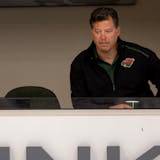Readers may be interested in what faculty members at the University of Minnesota think of the curricular requirements celebrated for their breadth and rigor by Vice Provost Robert McMaster in a recent counterpoint article ("Quality of curriculum at U is second to none," April 26).
McMaster, describing our set of liberal-education requirements as "comprehensive," states that "all students must complete seven courses in what we call the core"; he then lists 11 categories of requirements.
There is in fact no set of core courses. Rather, hundreds of courses have been submitted by individual faculty members for approval as meeting one or another of the liberal-education requirements, writing a proposal claiming that the course does this and adding similar claims to the syllabus. Proposal and syllabus are then submitted to the Council on Liberal Education. If the council finds the right words on the proposal and syllabus, the course is certified as meeting the selected liberal-education requirement. (You can see how many courses meet which requirements here: http://tinyurl.com/UMNOneStop.)
Thus no student need ever take, for example, a course in history. Students can satisfy the liberal-education requirement in "historical perspectives" by taking any course, in any college, that has been certified as meeting this requirement. Same with "mathematical thinking" and the other nine requirements. All of the approved courses may be fine components of a liberal education, but then, what university course isn't?
Faculty members submit courses for liberal-education certification under duress, in effect, because if we don't, our courses will get insufficient enrollment, inasmuch as students are constrained to choose courses that meet requirements. Many of us nonetheless find it absurd to be required to prove that a history course is a history course, a math course is a math course, and so on. The chorus of faculty discontent with this structure of requirements has reached such a pitch as to provoke a movement to change it.
Of the university's student learning outcomes, McMaster says faculty members use them "to make certain our undergraduates are indeed learning, and this learning is measured." Indeed, for every undergraduate course, faculty members are required to claim that it meets one of seven prescribed outcomes.
One would think the desired outcome of studying anatomy is to learn anatomy, that of studying Arabic to learn Arabic and so forth throughout the course catalog. But the student learning outcomes were intentionally written to be so broad that at least one of them could be construed to apply to any course or subject — including nonacademic ones.
Our athletics programs could make a sound case that, through their participation in a sport, student-athletes meet the learning outcomes McMaster lists. Surely members of the football team "can identify, define and solve problems," in practice and in play; they "can locate and critically evaluate information," with lightning rapidity on the field; they "have mastered a body of knowledge," namely, about football; and they can and must "communicate effectively" to play as a team. And "this learning is measured," all right, game by game.


